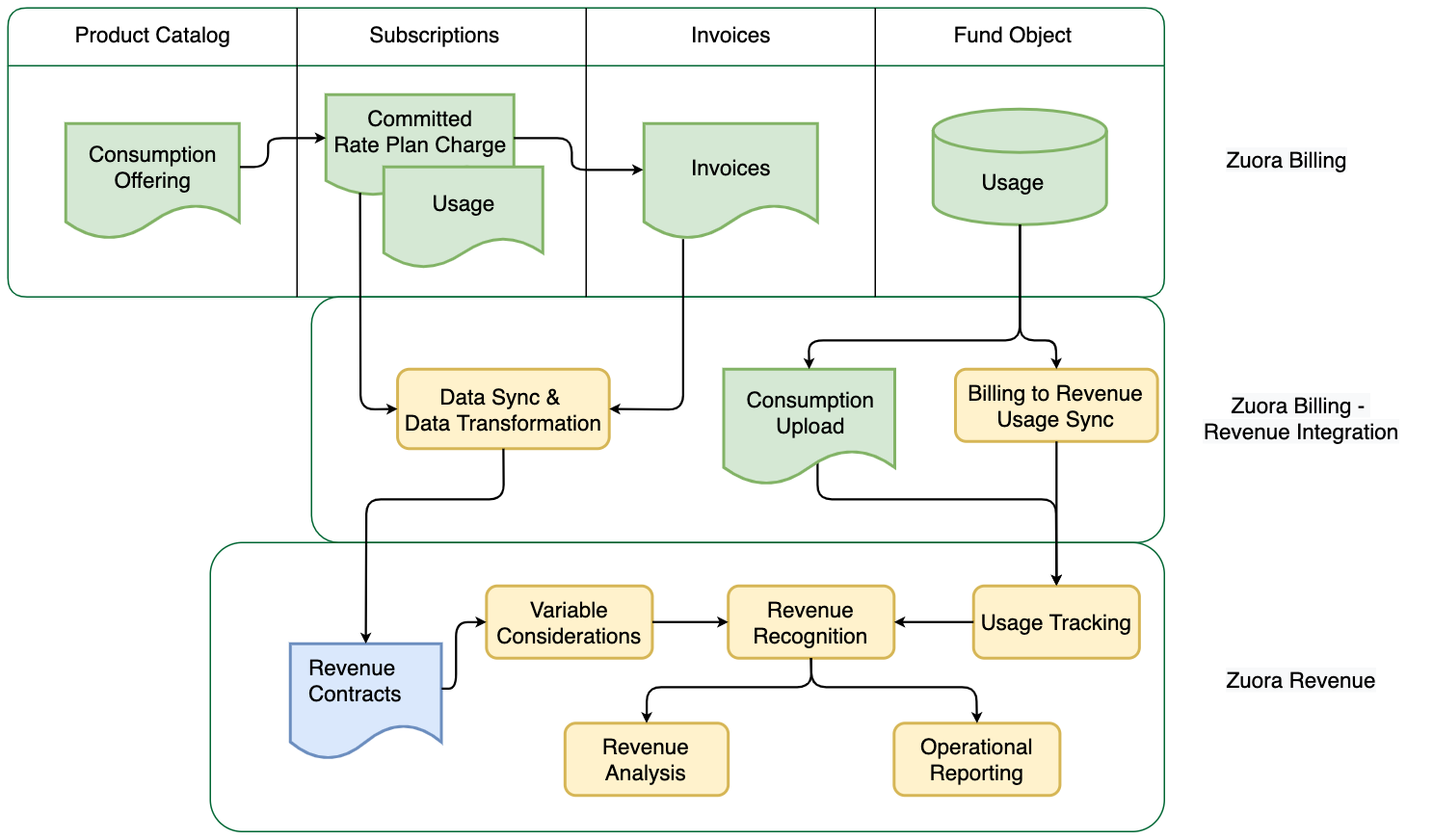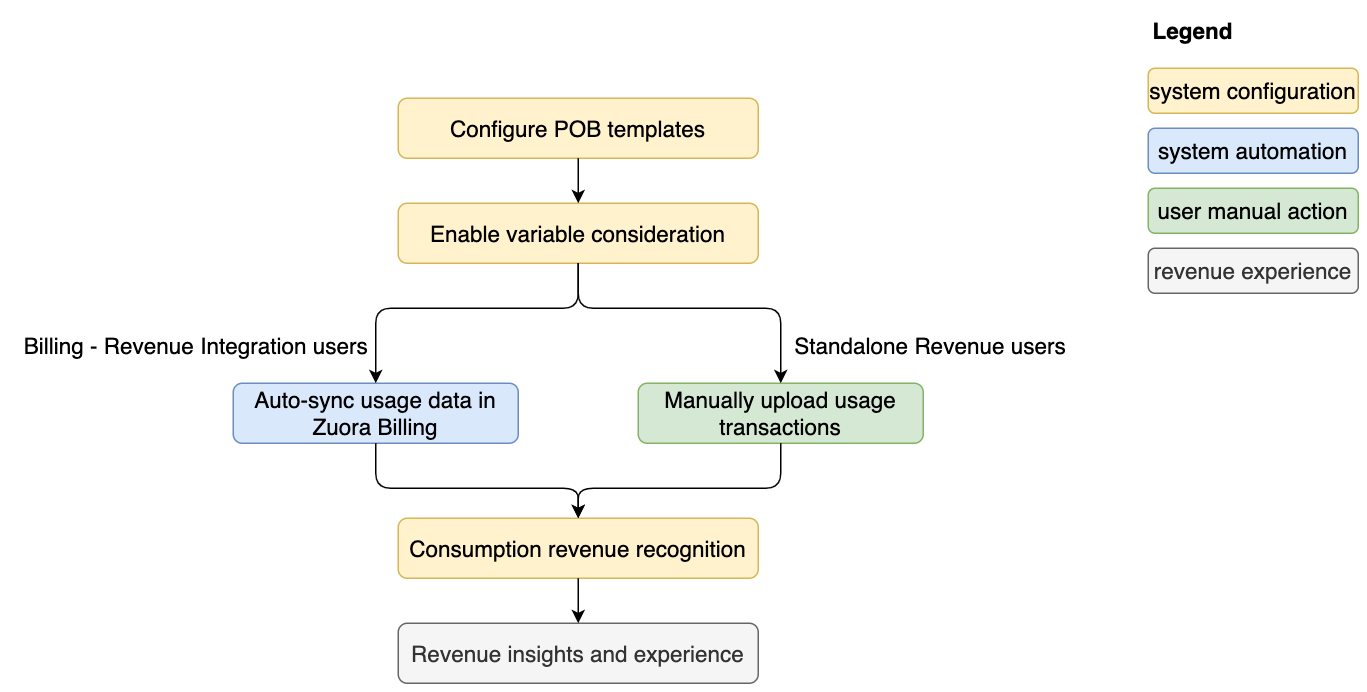Overview of Consumption Revenue
The Consumption Revenue functionality is available to both Billing - Revenue Integration environments and standalone Zuora Revenue environments. It provides a complete suite of features to support the Office of the Chief Financial Officer in operationalizing the Consumption model from the following perspectives:
- Revenue recognition
- Supports all consumption revenue recognition methodology in compliance with the US Generally Accepted Accounting Principles (US GAAP) and International Financial Reporting Standards (IFRS). This can be quite a complex endeavor for the Revenue Accounting team because the revenue policy for the Consumption model can be technical due to it also being multi-faceted. Oftentimes, it also requires analysis on whether Variable Consideration should be considered and how it should be treated.
- Data reconciliation
- Supports the reconciliation process with intuitive data and reports as a part of the user experience. This is inherently a challenge in all processes, but an important one in the Consumption scenarios because the transactions are most likely accumulated daily.
Business workflows
The following diagrams illustrate how Zuora Revenue envisions the business workflow. No matter whether you are a Zuora Revenue standalone user or a Billing - Revenue Integration user, you can benefit from the out-of-the-box features in regard to Usage Tracking, Revenue Recognition, Variable Considerations, Revenue Analytics, and Operational Reporting. These common features are explained below.
For Billing - Revenue Integration users, the integration layer in the middle of the diagram is the true differentiation. These integrations include data sync and transformation from subscriptions and invoices in Zuora Billing to revenue contracts in Zuora Revenue as well as the automation in transferring consumption and usage data from Zuora Billing to Zuora Revenue.
- Usage Tracking
- With this feature, the usage data from the upstream system can be manually uploaded from the UI into Zuora Revenue or automatically synced to Zuora Revenue if Billing - Revenue Integration is enabled.
- Revenue Recognition
- Two methods for consumption revenue recognition are provided. Revenue can be recognized either ratably over the term of the contract and released upon booking, or based on invoice and released at the maximized invoiced amount.
- Variable Considerations (VC)
- The Consumption Revenue functionality can also manage consumption models that are deemed stand-ready under the revenue policy where variable considerations accounting is necessary.
- Revenue Analytics
- Revenue insights are available for you to track and manage consumption events, usage events, and revenue actions.
- Operational Reporting
- Consumption usage data are applicable to standard reports.
| Zuora Revenue standalone users |  |
|---|---|
| Billing - Revenue Integration users |  |
Operational workflows
The following diagram illustrates the operational steps involved in the Consumption Revenue functionality for both Zuora Revenue standalone users and Billing - Revenue Integration users. The only difference between the two types of users is how the usage transactions flow into Zuora Revenue. The key feature or system configuration related to each operational task is explained in the subsections.

Standard consumption POBs
Zuora Revenue provides the following predefined POB templates. Configure the POB template to enable the appropriate POB templates based on your business needs. As explained in the following table, different templates are meant for different use cases. Note that only seed POBs must be used for consumption functionality. User-defined POBs will not be considered or supported in this context. For step-by-step instructions, see create advanced rules.
| Template name | Use case addressed |
|---|---|
| Consumption Ratable without VC | Revenue recognition is deemed to be ratable over the term of the commitment and there is no VC impact. The template is defaulted to start revenue recognition upon booking. Any usage transactions related to the POB will be recorded in Zuora Revenue for tracking purposes and do not dictate revenue recognition. |
| Consumption Ratable with VC | Revenue recognition is deemed to be ratable over the term of the commitment and there is VC impact. The template is defaulted to start revenue recognition upon booking. Any usage transactions related to the POB will be recorded in Zuora Revenue for tracking purposes and do not dictate revenue recognition. |
| Consumption PayGo | Revenue is recognized based on the usage transactions incurred or based on invoice events. This means no booked value or allocation is expected when this template is in use. The use case is the classic pay-as-you-go model for consumption therefore revenue recognition is triggered by usage transactions incurred or on invoice events. |
| Consumption - Usage Event |
The revenue recognition method is Immediate Using Open Period. There is a committed amount for this usage performance obligation. Zuora Revenue has a built-in validation to ensure that the recognized revenue amount does not exceed the committed amount. Revenue contract lines associated with this POB template can participate in allocations. For example, a usage-based contract is based on a committed amount of 100 dollars. Goods and services will drawdown against the agreed upon committed amount of 100 dollars. |
| Consumption - Usage Event (Non-Committed) |
The revenue recognition method is Immediate Using Open Period. There is no committed amount for this usage performance obligation. Zuora Revenue does not have any validation to cross-check the committed amount. Revenue contract lines associated with this POB template do not participate in allocations. It is because the committed amount cannot be identified at the commencement of the contract therefore no allocatable value can be identified. A typical use case is the classic pay-as-you-go model where billing is in arrears on a quarterly basis and the revenue recognition requirement is monthly accruals. This template can allow unbilled usage revenue to be accrued on a monthly basis based on the usage transaction events. For a system walkthrough based on a specific use case, see Use case of unbilled usage revenue. |
Enable VC types
If the POB template called Consumption Ratable with VC is in use, you need to enable appropriate VC types for this POB template to facilitate the VC accounting needs. The following VC types are predefined and meant for different use cases. For step-by-step instructions, see Enable VC types.
| VC type name | Use case addressed |
|---|---|
| VC Estimates_Consumption | This VC type is for revenue accrual of anticipated overages based on variable consideration estimation. The estimation amount is based on CSV upload or entered in the UI. The estimated amount will be accrued and amortized over the term of the contract. The estimated amount will expire upon the contract expiration date allowing end users to true up the usage amount by overage invoice or reduction in contract value. |
| VC Rollover | This VC type is for automation in calculating roll-forward balance based on the actual usage revenue recognized upon the cancelation and replacement of an existing consumption revenue contract. It triggers rollover of over-recognized or under-recognized revenue upon contract renegotiation when cancellation and replacement event takes place. If your company applies the rollover policy upon contract modification, use this VC type. |
Usage transaction management (Billing - Revenue Integration users)
With Billing - Revenue Integration enabled, the usage transactions can be automatically synced and transferred from Zuora Billing to Zuora Revenue. The following features are involved to address different use cases for Billing - Revenue Integration users to manage usage transactions. For more information, see Sync usage data to Revenue.
| Feature name | Use case addressed |
|---|---|
| Usage Sync |
If you enabled Billing - Revenue Integration, you will upload usage transactions and manage consumption subscriptions and orders with Zuora Billing. Then, the Usage Sync feature of Zuora Revenue will automatically sync and transfer the rated usage transactions into Zuora Revenue to trigger revenue recognition events and/or for usage tracking depending on the revenue recognition method. The Prepaid with Drawdown feature of Zuora Billing is also supported. |
| Consumption Upload |
This feature provides the ability to manually upload usage transactions to trigger revenue recognition events and/or for usage tracking depending on the revenue recognition method. Use this feature as a flexible fail-safe alternative only when necessary. The best practice for Billing - Revenue Integration users is always to use the Usage Sync feature as the primary way. Note that there is no system validation to prevent duplicate data uploads for Billing - Revenue Integration environments. If the same usage transactions are both automatically synced and manually uploaded to Zuora Revenue, it will lead to over-accrual because both sets of data will be processed. |
Usage transaction management (Zuora Revenue standalone users)
If you are a Zuora Revenue standalone user, the rated usage transactions must be manually uploaded to Zuora Revenue. For step-by-step instructions, see Manually upload usage transactions.
| Feature | Use case addressed |
|---|---|
|
Consumption Upload |
This feature provides the ability to upload rated usage transactions to trigger revenue recognition events and/or for usage tracking depending on the revenue recognition method. |
Consumption revenue recognition
The Usage to Revenue Conversion Frequency feature provides the ability to configure and schedule revenue accruals for the consumption-based SO lines. For step-by-step instructions, see Configure Consumption policy.
| Feature | Use case addressed |
|---|---|
| Usage to Revenue Conversion Frequency |
For users who use the Consumption Upload feature to upload usage transactions from the upstream system, use this feature to schedule the revenue accrual event for Zuora Revenue. A predefined job called RevPro3.0 Process Usage to Revenue Conversion will be scheduled to run to process the usage data and generate the consumption revenue waterfall. |
Revenue insights and experience
After usage transactions are processed, the Revenue Contract Detail page in Workbench provides the following windows or tables to track and manage consumption events, usage history, and revenue events. For step-by-step instructions, see Track usage consumption in Workbench.
| Workbench element | Use case addressed |
|---|---|
| Consumption History |
The Consumption History window presents the consumption event details at the SO line level. You can use it to do a quick analysis of revenue accrual versus usage transactions within Zuora Revenue. |
| Usage History | The Usage History window presents the usage transaction details at the SO line level. You can use this window to see the Usage Sync and/or Consumption Upload records at the line level to know when and how the usage transactions flowed into Zuora Revenue. If the usage record is manually uploaded to Zuora Revenue and the status is being tracked or yet to be recognized, the user can also cancel the record directly from this window. |
| Revenue Action | The Revenue Action window presents the consumption-related revenue events at the POB level. You can use this window to follow how much and when the usage revenue was released from a POB level as the revenue contract progresses through the lifecycle. |
